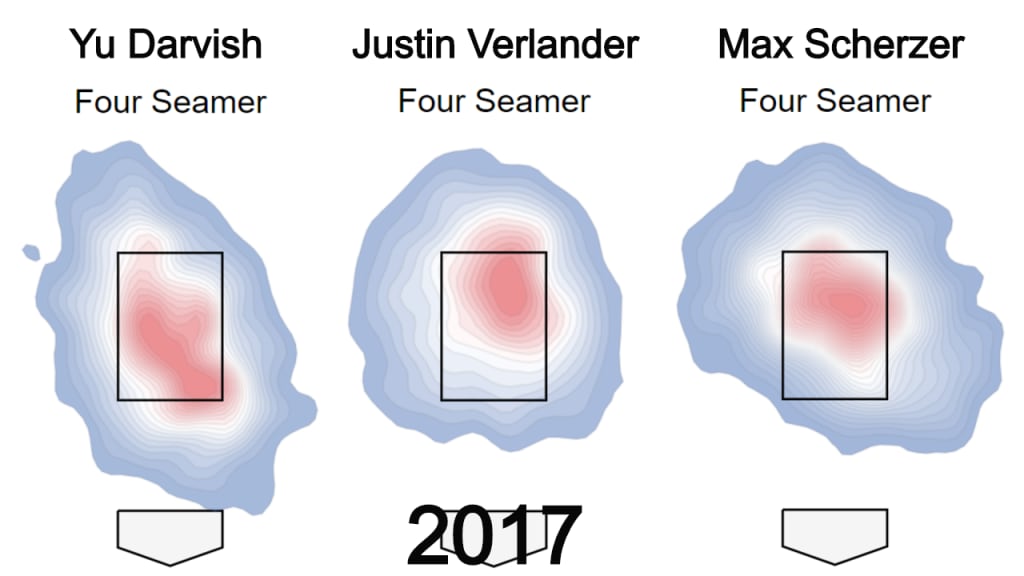Yu Darvish and the Cubs might be a perfect match. It goes beyond Darvish giving the reigning National League Central champs a front-line starter to replace Jake Arrieta. Few pitchers have an arsenal like Darvish's, wide-ranging and live-wire; in that respect, he'd boost any club.
But there's an area within Darvish's repertoire where there could be untapped potential -- and if anyone can help him unlock it, it's probably Jim Hickey, the Cubs' new pitching coach. Statcast suggests Darvish might be underutilizing a tool that was a hallmark of Hickey's tenure with the Rays: the high fastball.
With Tampa Bay, before reuniting with Joe Maddon in Chicago, Hickey instilled the high fastball as a foundational weapon for the Rays' pitching staff. Pitchers like Jake Odorizzi and Drew Smyly became heavy high-fastball users under his tutelage. But Hickey didn't have starting pitchers with fastballs like Darvish's.
Darvish's four-seamer not only sits in the mid-90s -- it also has elite spin. In 2017, across the regular season and postseason, his average fastball spin rate was 2,505 rpm. Of the 120 MLB starting pitchers who threw at least 500 four-seamers last year, Darvish had the second-highest spin rate, right between two of the game's true aces, Justin Verlander and Max Scherzer. The MLB average four-seam spin rate was just 2,256 rpm.
Highest avg. 4-seam fastball spin rate, SP, 2017
Minimum 500 4-seamers thrown
- Justin Verlander: 2,540 rpm
2) Yu Darvish: 2,505 rpm
3) Max Scherzer: 2,503 rpm
4) Dylan Bundy: 2,485 rpm
5) Sonny Gray: 2,484 rpm
One of the key insights from the three years pitches have been measured by Statcast is that a four-seamer with higher spin tends to get more swings-and-misses. The high spin creates the "rising fastball" effect -- the baseball defies gravity for slightly longer than the hitter expects, making him more likely to whiff.
With that rise, high-spin four-seamers can play especially well when the pitcher elevates them. Pitchers like Verlander and Scherzer make a living off blowing hitters away with high-spin, high-velocity fastballs up in the zone.
But while Darvish's spin is comparable to that of Verlander and Scherzer, there is a major difference when it comes to pitch location: Darvish doesn't focus on the high fastball like they do.
On average, a Darvish four-seamer in 2017 crossed the plate at a height of 2.36 feet off the ground. That was the 11th-lowest average four-seam pitch height out of those 120 starters who threw 500 four-seamers. Scherzer and Verlander, by contrast, had the exact same average four-seam pitch height of 2.80 feet. That means Scherzer's and Verlander's fastballs crossed the plate nearly half a foot higher, on average, than Darvish's. Those two ranked among the top 20 highest four-seamers.

The pitch heatmaps further illustrate the difference. Darvish threw his four-seamer in the upper third of the strike zone or higher only 31.5% of the time, the 15th-lowest rate of the 120-pitcher group. He threw his four-seamer in the lower third of the zone or below 45.9% of the time, the 14th-highest rate of all those pitchers.
Verlander elevated his four-seam 54.2% of the time, and he threw low fastballs just 25.5% of the time. Scherzer threw high fastballs 50.5% of the time and low fastballs just 24.0% of the time. Verlander and Scherzer were among the top 30 starters when it came to elevating their fastballs the most often, and they were in the bottom 20 starters when it came to throwing low fastballs. Again, they and Darvish were on opposite ends of the spectrum.
Plenty of pitchers work effectively with low fastballs. Clayton Kershaw, for example, elevates even less frequently than Darvish does. But Darvish has the high spin rate that Kershaw doesn't, and that suggests that the right-hander might be missing some opportunities to go upstairs.
When Darvish does throw his fastball high, the pitch has been much tougher on hitters than when he throws it low. On at-bats decided by elevated fastballs last season, Darvish held hitters to an expected wOBA -- a Statcast metric for overall performance based on strikeouts, walks and quality of contact allowed -- of just .239. Against Darvish's low fastballs, hitters posted an xwOBA of .340. His elevated fastballs were vastly more effective than his low fastballs.
For some context: The overall xwOBA on all elevated four-seamers thrown in the Majors last season was .320. On low four-seamers, the overall xwOBA was .389. So Darvish was better than average whether he threw his fastball high or low -- but his degree of separation from the rest of the league was much greater on his high fastballs. Darvish was 81 points of xwOBA better than average on high fastballs, versus 49 points better on low fastballs.
Darvish's high fastball was especially hard to hit. Last season, he ranked No. 1 in whiff rate on elevated four-seamers, of the 128 starting pitchers who had at least 100 swings against those high fastballs. Batters whiffed on 42.7% of their swings against Darvish's high heat. Of the 132 total swinging strikes Darvish got on his four-seamer last year, 82 -- nearly two-thirds -- came when he elevated.
Highest whiff rate on elevated 4-seamers, SP, 2017
Minimum 100 swings vs. high fastballs
1) Yu Darvish: 42.7%
2) Jacob deGrom: 39.6%
3) Rich Hill: 39.4%
4) Danny Salazar: 38.2%
5) J.A. Happ: 35.5%
Darvish's stats shouldn't be surprising. These are the type of swing-and-miss numbers a pitcher with top-tier fastball spin rate has the potential to post when he works up in the zone.
Darvish's fastball spin separates him from the majority of Major League starting pitchers. It's an edge his team should want to take advantage of. And he's come to the right place.


